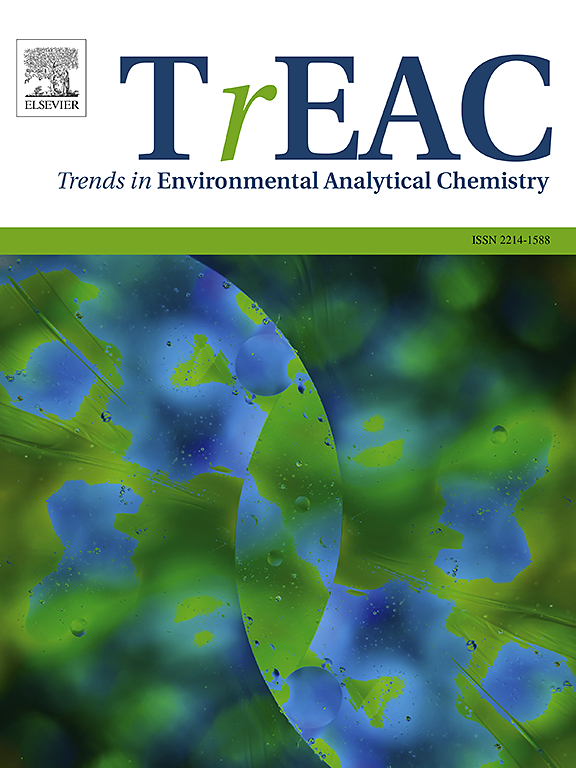Green analytical procedure index assessment for total petroleum hydrocarbons determination methods in soil and sediments. A review
IF 11.1
2区 化学
Q1 CHEMISTRY, ANALYTICAL
引用次数: 0
Abstract
Accurate determination of total petroleum hydrocarbons in soil and sediment is crucial for assessing pollution levels and guiding remediation efforts. This review looks at various analytical techniques for total petroleum hydrocarbons determination, such as gas chromatography with different detection methods, infrared based and fluorescence spectroscopic methods, in addition to gravimetric analysis. Green Analytical Procedure Index was used to investigate the environmental impact of the techniques along with different coupled extraction methods. Green Analytical Procedure Index individually evaluates the sample preparation, the type of instrumental technique, the reagents and solvents employed, the health and safety hazard, occupational hazard, and waste of each proposed analytical tool. This literature review showed that Soxhlet extraction, although ranked lower in greenness, is still one of the most widely used techniques for total petroleum hydrocarbons determination due to its completeness. Techniques like gas chromatography - mass spectrometer coupled with solid-phase microextraction, and infrared based tools with direct application are greener because the use of solvent is negligible, and the preparation of the sample is minimal. At the same time infrared based techniques showed lower prediction accuracy compared to gas chromatography - mass spectrometer coupled with solid-phase microextraction. This review highlights the critical need to balance analytical performance with environmental sustainability, offering insights into future developments in forensic and environmental monitoring. It shows pathways toward increasing the greenness of widely used techniques and future use in forensic investigations and environmental monitoring. Overall, this review is among the first to systematically assess total petroleum hydrocarbons analytical methods using Green Analytical Procedure Index, bridging the gap between analytical efficiency and green chemistry principles.
土壤和沉积物中总石油烃测定方法的绿色分析程序指标评价。回顾
准确测定土壤和沉积物中的石油烃总量对于评估污染水平和指导修复工作至关重要。本文综述了测定石油总烃的各种分析技术,如不同检测方法的气相色谱法、红外光谱法和荧光光谱法,以及重量分析法。采用绿色分析方法指数考察了不同耦合提取方法对环境的影响。绿色分析程序指数单独评估样品制备、仪器技术类型、所用试剂和溶剂、健康和安全危害、职业危害以及每种建议分析工具的浪费。这篇文献综述表明,索氏提取虽然在绿色度上排名较低,但由于其完整性,仍然是最广泛使用的石油总烃测定技术之一。气相色谱-质谱联用固相微萃取和直接应用的红外工具等技术更环保,因为溶剂的使用可以忽略不计,样品的制备也最少。同时,与气相色谱-质谱联用固相微萃取相比,红外技术的预测精度较低。这篇综述强调了平衡分析性能与环境可持续性的关键需求,为法医和环境监测的未来发展提供了见解。它显示了增加广泛使用的技术的绿色和未来在法医调查和环境监测中的应用的途径。总的来说,这篇综述是第一次使用绿色分析程序指数系统地评估石油总烃分析方法,弥合了分析效率和绿色化学原则之间的差距。
本文章由计算机程序翻译,如有差异,请以英文原文为准。
求助全文
约1分钟内获得全文
求助全文
来源期刊

Trends in Environmental Analytical Chemistry
Chemistry-Analytical Chemistry
CiteScore
21.20
自引率
2.70%
发文量
34
审稿时长
44 days
期刊介绍:
Trends in Environmental Analytical Chemistry is an authoritative journal that focuses on the dynamic field of environmental analytical chemistry. It aims to deliver concise yet insightful overviews of the latest advancements in this field. By acquiring high-quality chemical data and effectively interpreting it, we can deepen our understanding of the environment. TrEAC is committed to keeping up with the fast-paced nature of environmental analytical chemistry by providing timely coverage of innovative analytical methods used in studying environmentally relevant substances and addressing related issues.
 求助内容:
求助内容: 应助结果提醒方式:
应助结果提醒方式:


